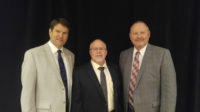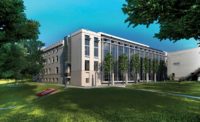Top Starts | Intermountain Owner of the Year
Utah State Has Broad Construction Reach
The northern Utah-based school is moving forward with multiple projects and a focus on sustainability

The Gateway parking terrace completed in 2020 was topped with solar panels, a sustainability feature campus planners expect to deploy on future similar projects as part of a commitment to sustainability.
Image courtesy of Utah State University
While record snows have covered the campus of Utah State University this winter, planners at Utah’s fourth-largest university have been anything but hibernating.
“Currently, we have approximately $264 million in projects that are either in the programing, design or construction phase,” says Ken Carrillo, director of planning, design and construction for USU.
As Utah’s land grant university, USU has a design and construction impact that can be felt statewide. In addition to its 400-acre main campus in the northern city of Logan, USU has 30 centers in its statewide campus network, including larger, regional campuses: Brigham City and Tooele in northern Utah; Moab in eastern Utah; Price in central eastern Utah; and Blanding in the southeast corner of the state. Directly north of the main campus, USU administers the 22-acre Innovation Campus, a collection of private start-ups and laboratories developing commercial applications from research conducted at USU primarily in the areas of aerospace, biomedical, animal and energy research.
Carrillo says in the coming year USU will perform sitework or break ground on several major projects, including the first facility at the new College of Veterinary Medicine, a new mixed-use academic building for the language programs of the College of Humanities and Social Sciences and expansions for a campus art museum and a start-up at the Innovation Campus.
“We’re also going to start work on a 500-foot extension of our utility tunnel at the south end of campus to serve a new residence hall, a new parking structure and an expansion of the business building that are in the planning phases right now,” Carrillo says. Additionally, USU has hired Salt Lake City-based AJC Architects to begin planning a new $14-million building at the school’s Monument Valley location that will include academic classrooms, nursing training and technical education space.
Carrillo says planning is also underway for an addition to the Nora Eccles Harrison Museum of Art (NEHMA) located on the main campus, funded in part by recent grants from the National Endowment for the Humanities and the state. Salt Lake City-based Sparano + Mooney Architecture is designing the $6.2-million NEHMA Art Research and Education Center that will connect to the existing museum.

The Mehdi Heravi Global Teaching and Learning Center will be the latest addition to USU’s Logan campus on a site adjacent to the university’s landmark central quad.
Image courtesy of Utah State University
New Buildings and Programs
Just over a year ago, USU officials announced they would create a College of Veterinary Medicine following funding approval by the state Legislature.
Salt Lake City-based VCBO Architecture is currently developing designs for the $64-million facility, which will include classrooms, laboratories and veterinary surgical suites. The building will be located on a brownfield site near the Innovation Campus.
Derek Payne, principal for VCBO, has worked on numerous projects over the years for USU, including the $45-million, 103,000-sq-ft Life Sciences Building, which opened in 2019. Payne says he’s always had positive experiences working with USU. “The good thing about them is they gather a stakeholder group early on. It is always a lot of people, but it’s the right people to make timely decisions when they need to be made,” he says. “They are extremely adept at collaborating with the design team, and when they make a decision, they rarely change it, and a project can move forward.”
“The state’s high-performance building standards are focused mostly on energy use and that is great, but we feel like real sustainability goes beyond that.”
—Jordy Guth, Associate Director of Planning, Design and Construction, USU
Construction for the newest building on campus got underway at the end of March. The nearly $19-million Mehdi Heravi Global Teaching and Learning Center designed by Salt Lake City-based Method Studio underwent a lengthy design process in the months prior to construction but is slated for completion next year, according to Trent Strayhorn, senior project manager for Ogden-based R&O Construction, the construction manager and general contractor for the project.
“When we bid this originally it was based on funding appropriated from the Legislature, but we’ve seen price increases that pushed the cost higher. We’ve been working with Method and the folks at USU to get the square footage down and redesign things to get it to a number everyone is comfortable with,” Strayhorn says. “It took a lot of work, but we had good collaboration with everyone.”
The new building will conform to the high-performance building standards dictated by the state Division of Facilities Construction and Management and will also be pursuing LEED Silver certification.
Jordy Guth, associate director of planning, design and construction for USU, says because the school is a land grant university, planners try to emphasize responsible use of land, sustainability and stewardship of natural resources and will regularly pursue LEED certification on projects.
“The state’s high-performance building standards are focused mostly on energy use and that is great, but we feel like real sustainability goes beyond that,” she says. “We want to take into account how the building works with the site, make the landscape a priority along with access to natural light, the effect on air quality and even how things like the glass and lighting of the building can effect wildlife like birds.”

The first building on the Moab campus is also the first net-zero building for USU. The remote location was a challenge for builders but set a new sustainability standard for future projects.
Image courtesy of Utah State University
Innovation and Tradition
USU’s new campus in Moab includes the first net-zero building in the university’s system. Sited on the edge of Arches and Canyonlands national parks, the building, designed by Salt Lake City-based MHTN Architects and built by Hogan Construction of Centerville, will generate more power than it consumes and is also on track for LEED Silver certification. The successful construction at the remote location was a considerable accomplishment according to Hogan estimating manager Russ Cox.
“USU Moab will set a new standard, not just for Utah State but for construction,” he says. “If you can achieve net zero in Moab, in a remote area, you can do it anywhere … with the right approach and the right amount of funds.”
Another unique and recently completed project is USU’s construction of a traditional Navajo hogan at the Blanding campus. Located in the southeast corner of the state adjacent to the Navajo and White Mesa Ute reservations, the campus hosts a significant number of Native American students, with 90% identifying as Navajo. Traditional craftspeople Benedict and Rena Daniels were assisted by Blanding-based Tri-Hurst construction in building the circular timber and earth-mounded structure. It was recognized as the Worship Project of the Year by the AGC of Utah.
Back in Logan at the Innovation Campus, Carrillo says preliminary work is underway for an expansion of the ASPIRE Engineering Research Center’s Electric Vehicle Research (EVR) facility. ASPIRE is a start-up company that emerged out of research by USU engineers. The company is developing charging technology for electric vehicles that includes systems embedded in roadways to enable wireless charging.
Carrillo says the start-up just inked a contract with the state of Florida and is looking at a $14-million expansion of their research facility and testing track.
In addition, in February, ASPIRE announced a partnership with Swiss train manufacturer Stradler to develop and test battery powered trains. The technology would allow passenger rail systems to operate without the need for overhead power infrastructure. Stradler recently built a manufacturing facility west of Salt Lake City and will test the technology there.
USU’s Guth says the ASPIRE facility has an array of solar panels, something the university has been trying to incorporate into more and more projects.

Ninety percent of the students at USU’s Blanding campus are Navajo. Last year a team of local builders and Navajo craftspeople completed work on a traditional hogan on campus. Built with locally harvested cedar and earth, it provides a unique space where students can go for meditation, quiet contemplation or study.
Image courtesy of Utah State University
“We don’t always want them on the rooftops of the buildings because it can complicate maintenance, but we want to push to have them over parking lots and parking structures,” she adds.
The Gateway parking structure completed several years ago at the east end of campus is topped with an array of solar panels, and Guth says a lower-tech program to replace all campus lighting with LEDs is nearly complete.
“A few years back we set some goals for greenhouse gas reduction and that was one way we found where we could get the most bang for our buck,” Guth says. “We’ve already seen a significant energy savings from that.”
With several significant projects in the rear-view mirror and more to come, Carrillo and Guth say they look forward to continuing to build relationships and work with firms across Utah.
“We’ve built some great relationships with contractors and design firms, and we really appreciate the level of talent we have here,” Carrillo says. “I feel like for quite a while firms were coming to us partnered with other, out-of-state companies. But recently we’ve had high-quality design and building teams showing us they can handle complex projects on their own and they’re doing a great job for us.”


